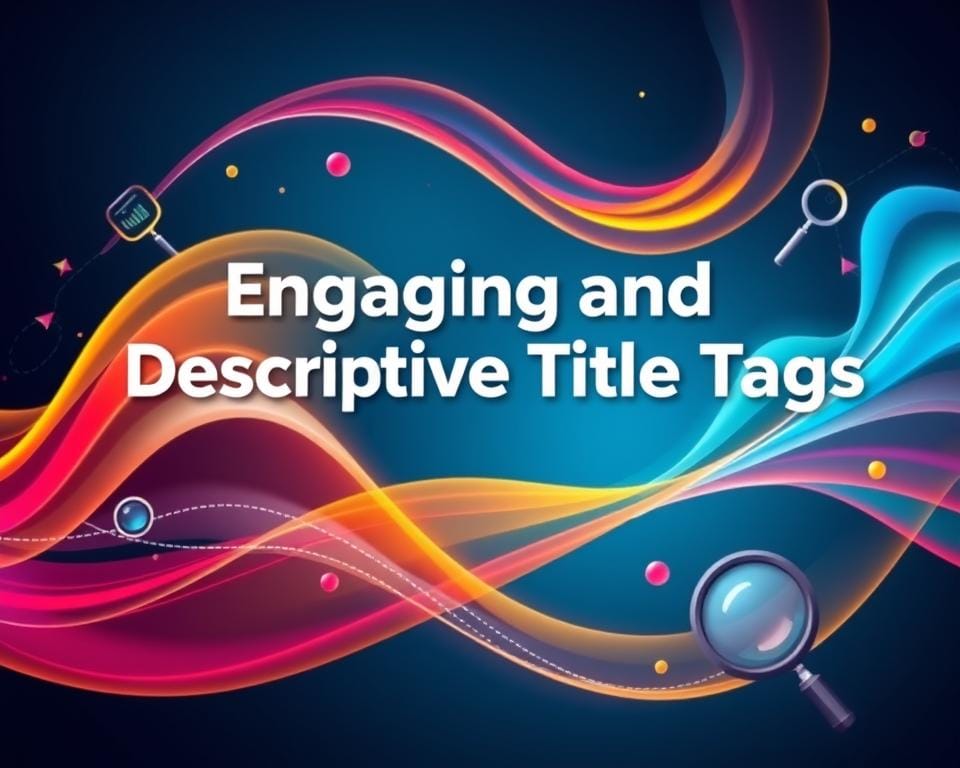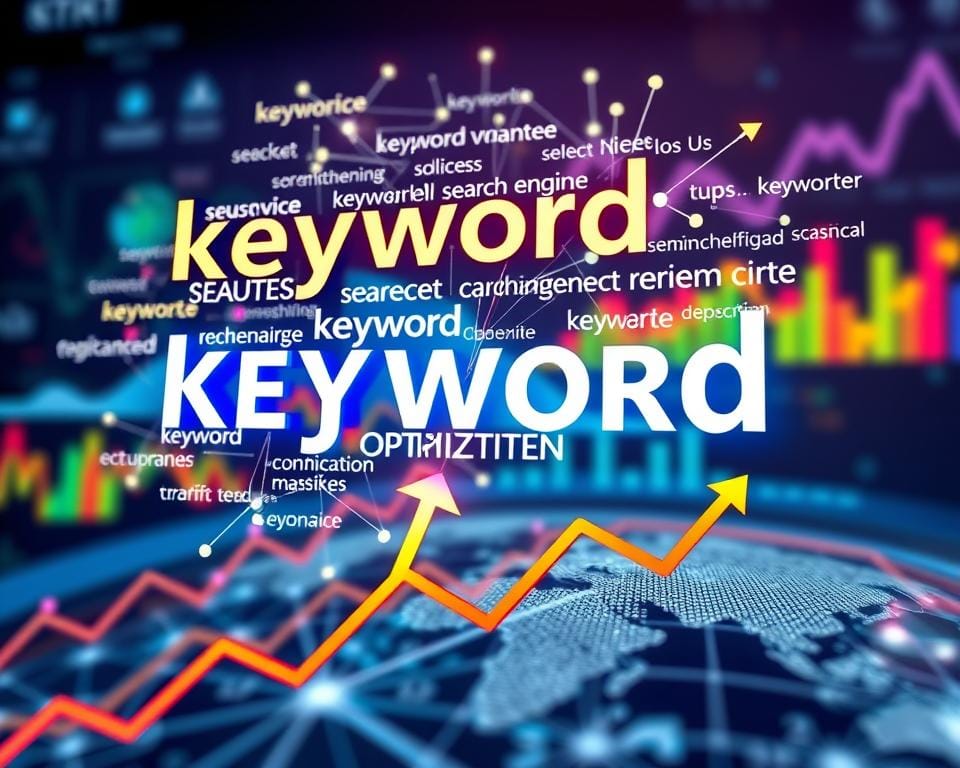Table of Contents
Did you know 75% of users never look beyond the first page of search results1? This fact shows how important title tags and metatitle tags are. They help your content get noticed. As SEO experts, we know making great titles is key to getting your site seen.
Using a well-optimized title tag is vital for search engines like Google Search. It helps them rank your page right. Creating standout title tags means using the right keywords and understanding what users want.
By optimizing these elements, we help improve your titles. They’ll rank better in search results and attract more users. For more tips on title tags, check out this guide on optimizing meta descriptions and web page.

A well-crafted title tag makes a big difference. It’s often the first thing visitors see. Make it clear, engaging, and relevant. Remember, our goal is to make your site easy to use, relevant, and appealing to search engines1.
Understanding Title Tags and Metatitle Tags
Title tags are key to SEO, acting as the main headline for a webpage. They appear at the top of browser windows and in search engine results pages (SERPs). They are crucial for optimizing titles and show the page’s content to both search engines and users.
What are Title Tags?
Title tags are HTML elements found in the tags within the section of a webpage. They are essential for valid HTML markup and play a big role in SEO. They help search engines understand and index the webpage’s content2.
They also display the page name in the browser’s title bar, making them very useful2. The element, while not directly affecting SEO, provides extra context for web applications2.
Title Tags vs. H1 Tags
Title tags and H1 tags have different roles, even though they might share keywords. Title tags are for search engines, showing the page’s main topic in SERPs. H1 tags, on the other hand, are within the content and represent the main heading users see2.
Keeping the two similar but not the same ensures clarity and optimization.
Title Tags vs. Meta Descriptions
The differences between title tags and meta descriptions are important for effective title optimization. Title tags act as brief, clickable headlines in SERPs. Meta descriptions, on the other hand, provide a summary of the webpage’s content2.
Title tags focus on concise page naming, while the tag is mainly used in blogs to explain content in search engine results2. This distinction is key because title tags improve SERP visibility and click-through rates. Meta descriptions, though, offer context and can influence user behavior2.
The Importance of Title Tags in SEO
Title tags are key in Search Engine Optimization (SEO), as Google’s John Mueller has said. They help search engines understand what a page is about. This makes a webpage more visible in search results when they are well-optimized3.
Optimizing title tags is crucial for being seen. It also helps get more clicks by offering clear, interesting headlines that match what users are looking for3.
Impact on Search Engine Rankings
Title tags can greatly affect how well a page ranks in search results. Studies show that using the main keyword in the title tag can boost organic search rankings by up to 30%3. Using a strong Keyword Strategy in title tags helps search engines understand and rank a webpage better. This can increase organic traffic by up to 50%4.
Influence on Click-Through Rates
About 65% of webpages have their title tags rewritten by Google if they don’t match the content or user intent3. A well-optimized title tag can increase click-through rates by up to 20% because it’s clear and relevant3. More than 80% of users say descriptive title tags make them more likely to click on a search result3.
It’s important to regularly check and adjust title tags based on Keyword Strategy to keep performance high and attract more visitors.
User Experience Enhancement
Good title tags make the User Experience better by giving a clear summary of the webpage’s content. This increases user engagement and can lower bounce rates by up to 40%3. Well-written title tags meet user expectations, making for a better browsing experience. When users find what they’re looking for quickly, they stay longer and are more likely to convert, improving SEO.
Best Practices for Optimizing Title Tags
Optimizing title tags is key to better organic traffic and more clicks. SEO experts start with keyword research to match user needs. This makes titles relevant and boosts search visibility.
We suggest using main and secondary keywords in title tags. Place important ones first for better visibility5.

Conducting Keyword Research
Keyword research is essential to find the right terms for our audience. Long-tail keywords can lead to better rankings5. Using them in title tags can improve SEO.
Integrate keywords in all meta tags, page content, and header tags. This approach is favored by search engines6. Tools like Google Search Console track keyword performance7.
Title Length and Character Limits
It’s important to keep title tags within the right length. Aim for 50 to 60 characters to avoid cuts in search results76. Staying at 55 characters is best for mobile screens76.
Titles over 65 characters might get cut off, hurting click rates7. Adding dates and numbers, like “10 Tips for Title Tag Optimization,” can increase interest while staying within limits5. Each title should be unique for clarity5.
By sticking to these guidelines, we can make title tags that boost SEO and user interest. This leads to more organic traffic to our sites.
Creating Engaging and Descriptive Title Tags
Making title tags engaging and descriptive is all about finding the right mix. They must grab attention and clearly tell what the page is about. A good title tag helps our site show up better in search results. It’s important to keep titles short and to the point, between 30 to 65 characters8

Getting title tags right can really boost our website’s click-through rates (CTR). For example, tweaking meta titles and descriptions can increase CTR by 20-30%9. Also, using compelling and keyword-rich descriptions can raise our average CTR by 5.8%8. This shows that well-written title tags are key to a strong online presence and more Organic Traffic.
Optimizing title tags means being creative but also following rules. They should be under 55-60 characters for the best display in search results10. Putting the target keyword at the start of the title can help rank higher in search results9. This approach makes our title tags both catchy and effective in drawing in Organic Traffic.
- Keep title tags concise, ideally between 30 to 65 characters8.
- Optimize titles to see potential CTR improvements of 20-30%9.
- Place main keywords at the beginning of the title for maximum impact9.
It’s also important to have unique meta descriptions. Over 50% of sites have duplicate descriptions, which hurts their SEO10. By making sure each page has a unique title tag and meta description, we can improve our website’s online presence. This attracts more clicks and helps lower bounce rates, which search engines value9.
Incorporating Keywords Effectively
For a strong SEO plan, using keywords well in title tags boosts your spot on Google Search. It’s key to know the difference between main and secondary keywords.
Primary vs. Secondary Keywords
Primary keywords are the main terms we aim for, like “SEO tips” or “digital marketing.” Studies show using primary keywords in title tags can really help your search traffic11. Secondary keywords add more detail and help with SEO without losing focus.
Natural Keyword Integration
Keywords should blend into title tags smoothly to keep them readable and avoid stuffing. Google’s smart algorithms can spot unnatural keyword use, which can hurt your ranking. Creating engaging title tags improves user experience and keeps your ranking up12.

Keyword Placement in Titles
Where you put keywords in title tags matters a lot. The main keyword should start the title. Titles with keywords at the start can show up better in search results11. Also, titles should be 50-60 characters long to avoid being cut off12. Bad titles that don’t match the content can hurt your ranking and trust with users, as Google’s Quality Rater Guidelines warn11.
Effective SEO comes from smart keyword placement and natural use. This strategy helps your content rank well on Google Search13.
Avoiding Common Title Tag Mistakes
Creating effective title tags is key for your website to be seen and used. Let’s look at common mistakes and how to avoid them. This way, we can make sure our title optimization is a success.
Keyword Stuffing
Keyword stuffing is a big mistake in title optimization. Using too many keywords makes titles look fake and can lower click-through rates by 20-40%14. It’s better to keep titles short and to the point. This way, they match the page’s content well and don’t get penalized by search engines15.
Try to keep titles between 50-60 characters. This helps Google show them fully and keeps users interested14.
Duplicate Titles
Using the same title on different pages is another mistake. It confuses both users and search engines, hurting your SEO15. About 25% of complex sites have this problem14.
Every page should have its own unique title. This makes it easier for search engines to find and show your page16.
SEO experts often find that title tags don’t match the page’s content. This is true for 40% of SEO audits14. Having titles that accurately represent the page is crucial for a good user experience and better SEO.
A good website builder makes it easy to create unique and relevant titles for each page. This helps a lot with SEO.
Title and Metatitle: The Synergy for SEO Success
The connection between title and metatitle is key for a strong SEO plan. Both parts need to work together for a great online look. Meta tags can boost click-through rates by up to 30%17.
Also, good meta descriptions can increase CTR by 5-10%. About 60% of users look at the meta description before clicking18. This makes the journey from search to web page better, leading to more engagement and sales. Companies with advanced meta tags see a 25% rise in organic traffic18.
It’s crucial to use clear and relevant keywords. Pages with fully optimized meta tags rank 10 spots higher18. Regular checks can cut down on abandoned meta tags by over 30%18.
Emotional triggers in meta titles and descriptions can boost CTR by 20%17. A/B testing these can improve performance by more than 15% over time17. About 75% of users don’t go past the first page of search results17. So, it’s important to grab and keep their attention with catchy titles and metatitles17.
An effective title and metatitle synergy follows best practices for Title Optimization and Meta Tags. It’s also key for a strong Online Presence. This mix of strategies can greatly improve a website’s performance, making it stand out in the digital world.
Analyzing and Updating Title Tags
Keeping title tags up to date is key for SEO success. They greatly affect how Google ranks our site in search results. This boosts our site’s visibility and traffic19. SEO experts know that titles over 60 characters get cut off by search engines. So, we aim for short, engaging titles that work on all devices20.
Changing title tags can significantly impact how many people click on our site. A good change can increase clicks by 15-20%, while a bad one can decrease them19. This is why we constantly check our tags to stay ahead in search results. About 80% of users prefer search results with their keywords in the title tag19.
Using numbers in titles can also make a big difference. Titles with numbers get 36% more clicks than those without19. Placing important keywords at the start of titles can also increase user engagement by 10-15%. This can help bring more organic traffic to our site19. For local businesses, adding specific locations can greatly improve local SEO20.
SEO specialists know that updating title tags regularly can increase organic traffic by up to 20% in six months19. This shows how important it is to keep our titles fresh and relevant. Also, having unique titles for each page helps both users and search engines understand our site better20.
For top-notch SEO, it’s crucial to remember that search engines might look at more than just title tags and meta descriptions to understand page relevance20. This means we need to optimize all our content for relevance and appeal.
In short, well-thought-out and regularly updated title tags are vital for better search visibility, more organic traffic, and higher engagement. They are a key part of our ongoing SEO efforts.
| Factor | Impact |
|---|---|
| Change in Title Tags | 15-20% variation in CTR19 |
| Character Limit Adherence | Full visibility on mobile and desktop20 |
| Keyword Inclusion | 80% user click preference19 |
| Use of Numbers | 36% higher CTR19 |
| Regular Updates | 20% increase in organic traffic over six months19 |
| Localization | Improved local SEO visibility20 |
Optimizing for Social Media Previews
Optimizing your title tags for Social Media previews is key to your online presence. It’s important to match these elements with your social media content. This helps drive coherence and engagement.
Using Snippet Review Tools
Snippet review tools are crucial for seeing how your titles and descriptions look on social media. They help spot any cuts, making sure your content looks good and complete. Since Google cuts titles at 60 characters and descriptions at 150, these tools keep your messages clear21.
Aligning Titles with Social Media Content
Matching your titles with your social media content makes your online presence stronger. With 61.6% of title tags being rewritten by Google, keeping your titles and social media content consistent is key22. This ensures your message stays the same everywhere.
Optimizing your meta titles can also boost user engagement. This leads to more clicks and better rankings in Google23. Plus, a well-aligned title encourages people to share your content, expanding your reach23.
Also, putting important keywords at the start of your titles can make them more visible. This is true for both search results and social media feeds22. Being consistent and strategic with your keywords optimizes your content. It ensures your digital footprint is strong across all platforms.
Conclusion
Title and metatitle tags are key in any SEO plan. They are the first things search engines and users see. Making them work well needs careful attention and knowing the best SEO practices.
Keeping titles short, 50 to 60 characters, and descriptions under 160 characters helps a lot24. It’s not just about fitting everything in. It’s about making titles that show what the page is about25. This helps search engines like Google understand your page better25. Also, good meta descriptions can make more people click on your site25.
Testing and improving these tags is important for lasting SEO success. As SEO experts, we need to keep up with changes in algorithms and how people use the internet. For website builders, this means starting with SEO in mind. This way, your site’s titles and descriptions will attract both users and search engines.
FAQ
What are title tags?
Title tags are important HTML elements that show the headline of a web page. They are also known as meta titles or SEO titles. They help search engines understand and index web content.
How do title tags differ from H1 tags?
Title tags are the main headline for a page and show up in search results and browser tabs. H1 tags are headlines within the page content. They should match but not be the same as the title tag. Title tags focus on SEO, while H1 tags focus on user readability.
What is the difference between title tags and meta descriptions?
Title tags are the headlines in search results and help with click-through rates and SEO. Meta descriptions are brief summaries of the content and help users decide to click on your link.
How do title tags impact search engine rankings?
Title tags are key for SEO rankings, as Google’s John Mueller confirmed. Good title tags help search engines understand your page’s content. This can improve your ranking in search results, making your site more visible and relevant.
How do title tags influence click-through rates?
Good title tags make users want to click on your link by being clear and appealing. When a title matches what a user is searching for, they are more likely to click.
How do title tags enhance user experience?
Title tags make sure users find what they expect on your page. A well-written title tag leads to a better experience on your site.
What are best practices for conducting keyword research for title tags?
Good keyword research finds keywords that match what people are searching for. Use these keywords in your title tags to help your content rank better and attract more visitors.
What is the ideal length for title tags?
Title tags should be short, around 50-60 characters. This ensures they show up fully in search results. Keeping them short helps with SEO and keeps users interested.
How can we create engaging and descriptive title tags?
Make title tags catchy and accurate by balancing creativity with SEO. They should grab attention, describe the page well, and meet user needs. This can make your page more visible and increase traffic.
How do we effectively incorporate keywords in title tags?
Use keywords naturally, with the main ones first and secondary ones where they fit. Avoid stuffing keywords, as it hurts your SEO. Placing keywords at the start makes them more visible and relevant.
What are common mistakes in title tag creation and how can we avoid them?
Avoid keyword stuffing and using the same title on multiple pages. Each page should have a unique, short, and well-optimized title that matches its content and purpose.
How do title and metatitle tags work together for SEO success?
Using the same title and metatitle tags shows your site’s topic relevance and authority. This boosts your SEO performance and gives users a consistent experience from search results to your site.
Why is it important to regularly analyze and update title tags?
Regular updates keep your title tags current with SEO and user trends. Monitoring them helps spot any issues or changes in search behavior, keeping your site competitive.
How do we optimize title tags for social media previews?
Use tools to see how your title tags and links look on social media. Aligning them with your social content improves engagement and consistency across all online platforms, leading to more shares and interactions.










